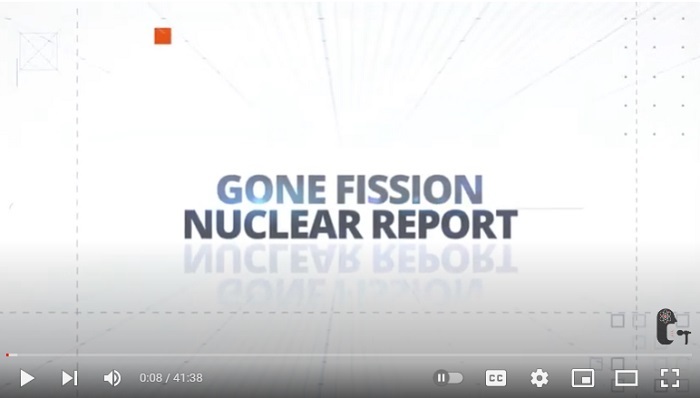|
Suraj Venkat Pochampally is a doctoral student and graduate research assistant in the Department of Mechanical Engineering at the University of Nevada, Las Vegas. In March 2019, Pochampally joined the EM Minority Serving Institutions Partnership Program (MSIPP), where he worked on technologies to detect and inspect nuclear environments, as well as another project on water remediation. In this Q&A with EM Update, Pochampally reflects on how the EM MSIPP has shaped his career goals to work on solutions to wastewater and groundwater contamination problems.

How did you learn about the EM MSIPP?
I first started working on the EM MSIPP project in March 2019, when my advisor, Dr. Jaeyun Moon, asked me to work on a collaboration project with another materials lab supervised by Dr. Kwang Kim. I was excited when I read the description of the project that focused on fabricating a flexible robotic platform for detection and inspection in nuclear environments. Working on that project, I gained knowledge about nuclear environments and the wide range of problems associated with them.
In January 2020, I started working on another EM MSIPP project: a water remediation project supervised by Dr. Moon and Dr. Erica Marti titled “Green and Cost-effective Remediation of Organic Contaminants in Subsurface Environments; Production and Modification of Biochar from Local Feedstocks, Pilot-scale testing with Enhanced and Massively-produced biochar.” This project dealt with the treatment of trichloroethylene (TCE) and tetrachloroethylene (PCE) from groundwater in collaboration with the Savannah River National Laboratory. Soon, I was the lead Ph.D. student for this project, working with a diverse group of students, and that gave me a lot of exposure to develop myself into a skilled researcher.
How is EM MSIPP helping you work on your career goals?
Working in the EM MSIPP has done wonders for my professional and academic life. By working on this project, I have had the opportunity to interact and mentor various researchers and students, improve my research and engineering skills, attend various conferences to learn about groundbreaking research that is being conducted by various skilled researchers around the world and network with several academic and industry professionals.
By working on the EM MSIPP-funded project on organic contaminant remediation, I have gained a lot of knowledge and experience on carbon adsorbents and water treatment, and I would like to use this knowledge to work on the wastewater and groundwater contamination problems in the environment after I finish my Ph.D. By working on this project, I have also had the opportunity to work on authoring two manuscripts that I plan to publish in high-impact factor journals. I am working on the final review for the first manuscript and I am on track to submit it to a journal this month. My colleagues and I are almost finished with the second manuscript and should publish it by the end of this year.
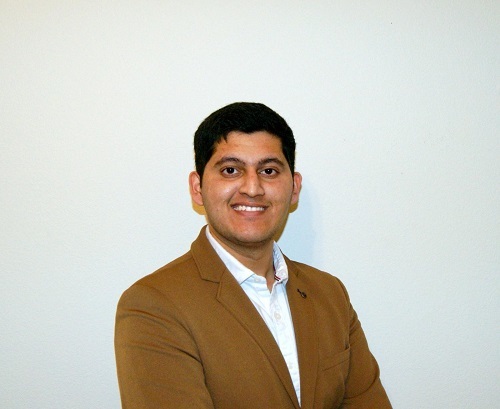 |
|
Suraj Venkat Pochampally, a doctoral student and graduate research assistant in the Department of Mechanical Engineering at the University of Nevada, Las Vegas. |
What do you enjoy most about EM MSIPP?
I loved working with a diverse group of students as part of the research group. I have had the opportunity to mentor 10 students over the three years that I have been a part of the EM MSIPP research project. That experience has not only improved my mentorship abilities but also improved my ability to understand students and their problems. I also loved being a part of the EM MSIPP first annual Competitive Research Award Workshop held in Augusta, Georgia in August 2022, and had the opportunity to meet the people who made this program possible.
What goals have you set for yourself after graduation? What do you hope to do?
I plan to graduate with my Ph.D. in mechanical engineering soon and I would like to continue being associated with DOE and its programs. That would only be possible if I work as a post-doctoral scholar at one of the national labs. There are many DOE research labs in the U.S., like Pacific Northwest National Laboratory and Savannah River National Laboratory, that are equipped to conduct groundbreaking research in material sciences, and I would absolutely love to work in one of those labs as a postdoctoral scholar.
I am putting all my efforts into becoming a skilled researcher and I believe that I have a suitable educational background, gained from my research experience working in the EM MSIPP for the past three years, to accomplish my goals. I hope that the connections I made in the past three years while working on the EM MSIPP project will help me greatly in achieving this.
Anything you’d like to add about EM MSIPP? Final thoughts?
I would like to thank everyone related to the EM MSIPP that made it possible, and I hope to be a part of the program even after I graduate. I would like to add that it would be an even greater help if EM MSIPP could start offering internship or fellowship opportunities to international graduate students in the program, where the students can visit and work in one of the national labs and learn about the research going on there and the work culture. This will make it easier for them to continue in the EM MSIPP project even after they graduate, in the form of post-doctorates and full-time jobs.
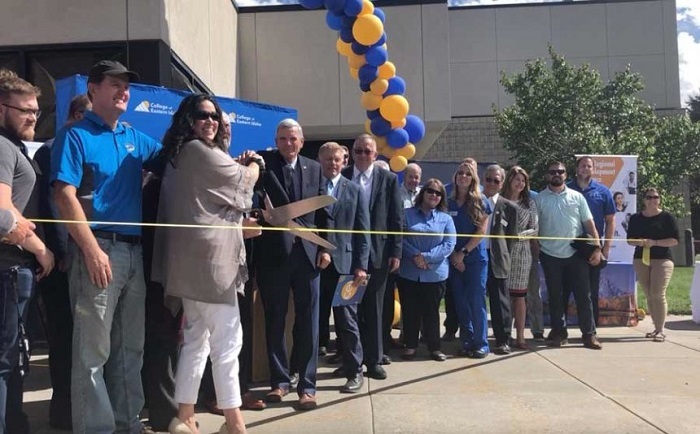 Community leaders and many others turned out for a ribbon-cutting ceremony recently for the workforce training center in Idaho Falls, Idaho. EM contractor Idaho Environmental Coalition helped to spearhead the effort to provide a workforce training center to train workers for a variety of job skills needed by regional employers. Photo courtesy of East Idaho News.
IDAHO FALLS, Idaho – An EM contractor at the Idaho National Laboratory (INL) Site recently carried out a plan to create a pipeline of skilled employees to help meet the needs of the cleanup program but also benefit private industries in the area.
Contractor Idaho Environmental Coalition (IEC) was instrumental in establishing a workforce training center to cater to the health care, agriculture, manufacturing, construction and public safety industries in Bonneville County and surrounding areas. Through the center, prospective employers will sponsor students as they learn skills needed by the employers. In exchange for the sponsorship, students will commit to work for their sponsors for a prescribed time.
IEC Strategic Initiatives Director Dana Kirkham said the center, which celebrated its opening with a ribbon-cutting ceremony in September, will provide specific skills to students, making them marketable in certain industries upon program completion.
“This will bridge the gap for students who graduate from high school and want a quick, viable career path,” she said.
Kirkham said both school districts in Idaho Falls expressed interest in the center because it benefits vocational-technical students who don’t want to attend a college or university after graduation. In addition, the center will be used by industry to provide upskill training to their existing employees. Between new employee training and enhancing the skills of the existing workforce, the center is anticipated to be well utilized.
Idaho is currently one of the fastest-growing states in the country. An influx of new residents has put additional strains on industries in eastern Idaho struggling to fill hundreds of available positions.
IEC partnered with an eastern Idaho community college to train radiological control technicians for INL Site jobs. That ongoing program has been extremely beneficial to both the company and graduating students.
“Our partnership with the local community college has proven that as an employer, you get the greatest benefit when you invest in the training of your future employees,” Kirkham said. “The workforce training center will operate with the same mindset.”
She said the workforce training center will benefit not just IEC but many employers in eastern Idaho who need, for example, building framers, trained hospital staff and skilled farm employees.
Bonneville County donated an existing building for the workforce training center. Complete with a board of directors and partners, the center is in business and looking forward to its first wave of graduates next year.
-Contributor: Erik Simpson
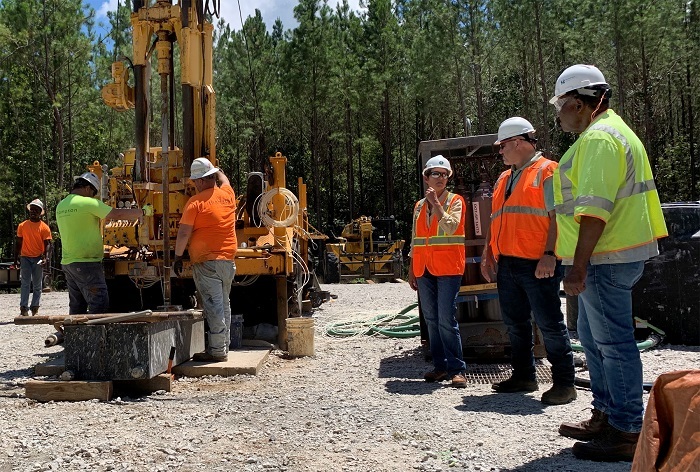 Using an innovative metal piercing device and cement-like grout, Savannah River Nuclear Solutions (SRNS) saved about $900,000 in a project that safely closed a 70-year-old well at the Savannah River Site. Karen Adams, third from right, DOE-Savannah River federal project director, discusses progress on the project with Allen Henderson, far right, SRNS subcontract technical representative and Joao Cardoso-Neto, SRNS project manager, Area Completion Projects.
AIKEN, S.C. – EM crews employed a unique solution to safely close a 70-year-old well at the Savannah River Site (SRS), saving about $900,000.
Employees with EM contractor Savannah River Nuclear Solutions (SRNS) conducted research to find an alternative approach for the closure of the 600-foot-deep, large-diameter well. The solution they found costs much less than the traditional approach, which risks harm to the environment.
“Conventional methods would have involved drilling out the well and grouting the entire borehole, which would have been extremely expensive and could have potentially contaminated an aquifer that the well tapped deep beneath SRS,” said Joao Cardoso-Neto, project manager, SRNS Area Completion Projects. “Instead, research revealed that a special tool could perforate the well’s carbon-steel casing, allowing cement-like grout to be forced through multiple openings under pressure.”
The tool punches vertical slots through the casing wall at a targeted depth. This is accomplished when 3,000 to 4,000 pounds of force pulls up a metal rod, driving a thick steel blade on the rod through the pipe.
The production well was installed during construction of the Savannah River Plant, now called Savannah River Site. Eventually, the U.S. Geological Survey (USGS) started using the well to collect data related to groundwater levels in the site’s M Area. It was one of several unusually deep wells drilled across the 310-square-mile nuclear reservation in the early 1950s.
The USGS is the nation's largest civilian mapping and water, earth and biological science agency. It collects, monitors and analyzes natural resource conditions, issues and problems, and provides scientific understanding of them.
Proposals were solicited from multiple firms on the best way to close the large, deep well, whose design does not comply with current environmental protection standards. SRNS protégé small business CTI and Associates and its subcontractor developed an innovative closure plan involving the special tool. The team provided the equipment needed to perforate the well and grout it using a pressurized system to ensure a contiguous column of grout through the entire well. Approximately 4,500 gallons of grout were required to complete the task.
“Wells of this type can be found across the Department of Energy complex at multiple sites,” said Karen Adams, DOE-Savannah River federal project director. “Our desire is to pioneer and share this technology and highly efficient approach to closing archaic wells that are not environmentally sound. Working closely with SRNS Area Completion Projects personnel, CTI has helped ensure the environmental protection of this portion of the site per South Carolina Department of Health and Environmental Control requirements.”
-Contributor: DT Townsend
 A tanker unloads at a backup load-in station at the Effluent Treatment Facility on the Hanford Site. Driver Nick Bass delivers 6,200 gallons of leachate collected from a mixed-waste burial trench.
RICHLAND, Wash. – EM Office of River Protection (ORP) tank operations contractor Washington River Protection Solutions (WRPS) recently completed construction of a backup load-in station at the Effluent Treatment Facility (ETF) — another step in preparing for tank waste treatment on the Hanford Site.
Watch a time-lapse video of the backup load-in station construction here.
“We broke ground on the backup facility about a year ago,” said Rob Wood, WRPS project manager. “I am proud of the team for completing this portion of the load-in expansion project and doing it safely. In phase two, expansion of the main load-in station will prepare us for 24/7 operations on the Hanford Site.”
The backup facility is handling waste transfers from across the site while crews work to expand the main wastewater load-in station at the ETF. Last month, the first tanker unloaded 6,200 gallons of low-level leachate at the backup facility. Leachate is water from rain, snowmelt and dust suppression activities.
Click here to watch a time-lapse video of the first tanker truck at the new backup facility unloading low-level leachate collected from a mixed-waste burial trench.
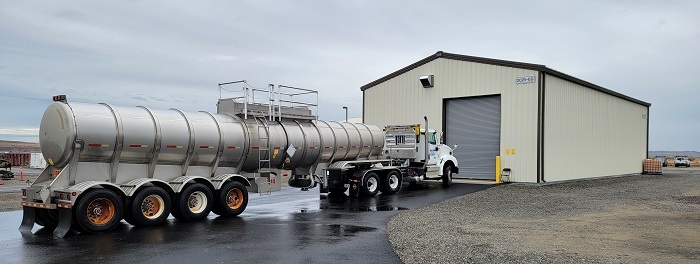 The backup load-in station at the Effluent Treatment Facility will handle liquid waste transfers from across the Hanford Site while the main load-in station undergoes major renovations and expansion to support tank waste treatment operations.
With the backup facility in operation, demolition has begun on the main load-in station interior. The building will also be extended 30 feet to allow tanker trucks to fit completely inside, and a new unloading platform will be constructed, allowing the drivers to better communicate with the facility operators. Modifications will also enable an additional tanker to prepare for unloading while another tanker is being emptied, which will nearly double the building’s capacity.
“Expanding the load-in station is a key part of our Direct-Feed Low-Activity Waste Program for treating tank waste,” said Bibek Tamang, ORP’s ETF program manager. “This backup facility is phase one of construction and will carry us through the next six months of construction on the new facility.”
During tank waste treatment operations, additional leachate will be processed at the ETF. The leachate will be collected and sent from the site’s Integrated Disposal Facility. Approximately 1.2 million gallons of leachate per year is expected to be sent to the ETF during the operations.
-Contributor: Joan Lucas
 X-326 Process Building Demolition Project Director Mike Furner, right, talks to a tour group in July about progress being made on cleanup efforts at the former Portsmouth Gaseous Diffusion Plant.
LEXINGTON, Ky. – EM’s Portsmouth/Paducah Project Office (PPPO) sites in Portsmouth, Ohio and Paducah, Kentucky recently wrapped up their 2022 public tour campaigns, which garnered high interest from the public.
The Portsmouth Site offered four tours with a total of 82 visitors while the Paducah Site hosted just over 100 people during a total of three separate tours.
The tours were relaunched on July 16 for the Portsmouth Site and Aug. 27 for the Paducah Site after coronavirus restrictions paused the 2020 and 2021 tour schedule.
With nearly a two-year pause on public tours, the PPPO sites are pleased the public continues to remain interested in the sites’ history and cleanup efforts.
“The public site tours offer a unique opportunity for participants to experience the cleanup progress at close proximity,” PPPO Site Manager Joel Bradburne said. “It also allows tour goers to take a step back in time and understand the history as well as what the sites were like prior to cleanup.”
Both sites expect tours to pick back up in the spring next year.
Click here for information about Portsmouth Site tours and here for information on Paducah Site tours.
-Contributor: Zachary Boyarski
|


